

ALGIZ 10X improves order fulfillment at 150,000-square-meter warehouse
NAUTIZ X8 provides communication and navigation support for glacier explorer
Fast, discreet radiation monitoring — Inconspicuous NAUTIZ X8 makes it easy
Timber buyers increase accuracy, efficiency and profits with rugged handhelds
Algiz 10X emergency response system improves efficiency for ambulance workers
Nautiz X3 helps meat distribution company improve quality control in refrigerated storage facilities
Nautiz X8 helps GIS professionals calculate utility pole measurements
Great Lake Energy uses Algiz 7 computers used in SHESH project
Algiz 10X computers used in telemedicine case
Nautiz X4 computers improve logistics and cargo monitoring for a Scandinavian transport company
Handheld CEO: Rugged computers a game-changer in critical field rescue situations
Handheld CEO: Rugged Computing Key Trends in 2015
Handheld CEO: Rugged Computers Are More Than Just 'Hard Shells'
Handheld CEO: The Trend Towards 'Ruggedish' Computers and Smartphones
Technology for Technicians: 2013 Trends
Handheld CEO: How to Purchase Mobile Computers Wisely
Case Study: Computers in Diving and Marine Exploration
Handheld Group Business Partner Conference 2010, Stockholm
|

|

|
|
|
Handheld Algiz XRW
A mobile computer for anyone who's been waiting for a rugged netbook
(by Conrad H. Blickenstorfer)
On September 14, 2010, the Handheld Group introduced the Algiz XRW. Handheld calls it a "fully rugged laptop" that features "cutting-edge technology and communication possibilities in an ultra-mobile form factor, at best value available on the market." We call it a rugged netbook. Yes, what Handheld offers with the Algiz XRW is something a lot of folks in the field have been waiting for—a fully ruggedized version of those handy little notebooks that fit anywhere and that have been selling in the tens of millions.
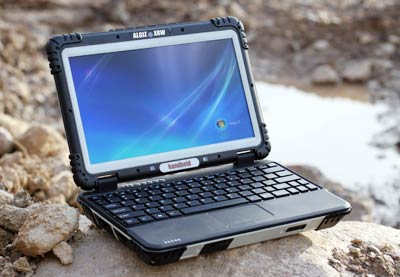
That said, is the Algiz XRW really small and handy enough to qualify as a rugged version of a netbook? It is. Its footprint is 10.2 x 7 inches. That of one of the most popular 10-inch netbooks, the Acer Aspire One, is 10.2 x 7.3. The Algiz is a bit thicker (1.6 versus 1.3 inches) and weighs a bit more (3.3 pounds versus 2.6 pounds). Considering that the Algiz features the same size 10.1-inch display but is almost infinitely more durable than a consumer netbook, that is a remarkable accomplishment. In essence, field personnel now can take a full-feature netbook along on jobs where no standard netbook would survive.
But does Handheld's rugged netbook also deliver state-of-the-art netbook features and performance? It does. First and second generation consumer netbooks had displays with WSVGA 1024 x 600 pixel resolution that was just not quite enough for today's apps and websites that usually assume full XGA (1024 x 768 pixel). Many current generation netbooks have switched to 1366 x 768 "HD basic" resolution that offers a much more practical user experience, and that is what the Algiz XRW comes with. It is also considerably more resolution than a lot of rugged mobile tablet and laptops offer.
In terms of tech specs, however, the Algiz XRW differs from consumer netbooks in small but meaningful ways. While almost all netbooks are powered (or as many say, underpowered) by the ubiquitous 1.6GHz Intel Atom N270 or its 1.66GHz N450 successor, Handheld chose a chip from the more industrially oriented Z5xx series of Atom processors. But while the 1.6GHz Z530 has been the processor of choice for most industrial/vertical market mobile devices, Handheld picked the significantly more powerful 2.0GHz Z550 version that should provide performance above the level usually expected from a netbook class machine.
Finally, while most commercial netbooks have been using 160GB hard disks, the Algiz XRW comes with a 64GB solid state drive that's faster, more reliable, and much more resistant to damage. And while most commercial netbooks still come with just 1GB of RAM, the XRW has two, which makes much more sense when you're running Windows 7 (we were initially told the XRW would run Windows Embedded Standard 7, but the initial release seems to come with Windows 7 Ultimate).
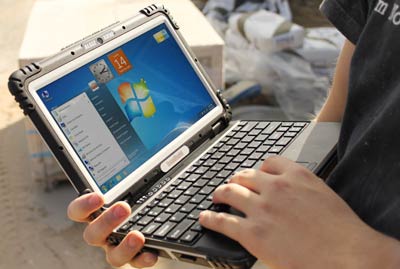
Design and construction
Handheld showed a prototype of the Algiz XRW (which stands for "Xtreme Road Warrior") at its June 2010 Partner Conference in Stockholm. The overall look and feel was that of an elegant device that neatly fits into Handheld's new design language of light-gray/black colors and fully integrated protective rubber bumpers and protective covers. Not much has changed in the final product: the look is that of an elegant, ruggedized netbook computer.
The XRW's keyboard very closely follows standard netbook layout and size, though both the keyboard and touchpad are fully sealed. This means a rubber keyboard instead of the conventional bevelled key caps found in most consumer netbooks. Keyboard illumination is not via illuminated keys, but through two small LEDs located beneath the LCD display. One area where we'd have liked to see Handheld depart from standard netbook practice is in the size of the all-important QWERTY part: it's only 90%-scale, which means anyone used to a full-scale keyboard may trip over the narrower key spacing. This is a suggestion we've had with designers of mobile keyboards for many years: make the QWERTY part full-scale by making the punctuation keys to the right of it narrower!
Like almost all netbooks, the Algiz XRW doesn't have a touch screen. Likewise, the display is fixed and does not rotate to turn the XRW into a tablet. So this is not a smaller version of a convertible notebook. Instead, it's a much tougher version of a standard netbook. That, however is where the similarity to most consumer netbooks ends. Apart from the high 1366 x 768 pixel resolution, the display also uses Handheld's sunlight-readable "MaxView" technology. We haven't seen it in action on the Algiz XRW yet, but if MaxView performs as well on this machine as it does on Handheld's Algiz 7 that we recently tested, expect exemplary outdoor viewability as well as glare and reflection-free operation.
As far as battery life between charges goes, Handheld claims about eight hours from the very generously sized 58 watt-hour Li-Polymer battery. The extended battery of about the same capacity on our Acer Aspire One netbook routinely lasts eight to ten hours, so between the XRW's frugal Atom processor and Window's 7's excellent power management, eight hours should definitely be doable.
In terms of connectivity, the XRW has two USB 2.0 ports, a video port, a legacy DB9 RS232 port, and audio in/out jacks. There's also a contact-pin docking connector, and the SD Card slot is SDXC compatible, which means it can theoretically handle cards up to 2 TB.
On the wireless communication side, the unit comes with Bluetooth v2.0 with EDR (Enhanced Data Rate), 802.11b.g.n WiFi, a Mediatek GPS receiver, and optional HSDPA/3G WWAN via PCIe. The unit is also GOBI2000-ready, which means it can be equipped with a radio module that is almost totally carrier and technology independent and lets users select whatever wireless data service is available at their location.
Another feature where the Algiz XRW surpasses most commercial netbooks is its integrated camera. While most consumer netbooks use just 640 x 480 resolution, the XRW has a 2-megapixel camera that's much more useful for documentation purposes as well as conferencing on the unit's high-res display.
Ruggedness
Ruggedness, of course, is what the Algiz XRW is all about. So how rugged is it? Very.
That starts with an extremely wide operating temperature range of -6 to 158 degrees Fahrenheit. To give you an idea, commercial and household freezers are about zero degrees Fahrenheit, with some commercial ones as low as -10F. And 158F is hotter than Death Valley ever gets, so it's safe to say that, temperaturewise, the Algiz XRW can handle more than most humans.
Computers get dropped in the field all the time, and the XRW has been drop-tested according to the MIL-STD-810F, Method 516.5, Procedure IV that mandates 26 drops from four feet. That's about standard for what we'd expect from a device like the XRW. Handheld also used the MIL-STD-810F to test for vibration, humidity and a variety of other criteria.
Sealing is key for a machine of this type, and the Algiz XRW carries an IP65 rating. The "6" means the device is totally sealed against dust, and the "5" that it is protected against low pressure jets of water from all direction, but with limited ingress still premitted. Ideally we'd like to see IP67 here, which would mean it could also survive a possible drop into a stream (which can happen in the field).
Summary
With the Algiz XRW, the Handheld Group offers an enhanced, ruggedized version of a netbook computer. Its small size and weight make it possible to offer the conventional notebook form factor and functionality in situations and applications where larger, heavier notebooks simply aren't practical.
Apart from its handy size, the device offers above-average computing power in this class, but without giving up excellent battery life in the full-shift range. Also appreciated are the 10.1-inch daylight-vieawable wide-format display with its 1366 x 768 pixel resolution that's suitable for today's more information-intensive applications and websites. We'd have liked to see a touch screen option and a full-scale QWERTY layout, though.
The Algiz XRW is rugged enough to be used in almost any environment, and its integrated bumpers protect against dents and scratches.
Like all specialized vertical market computing equipment, the price is much higher than for consumer equivalents, but in terms of functionality to the job and total cost of ownership, the unit is a veritable bargain.
Overall, the Handheld Algiz XRW addresses the needs of anyone who's been looking for netbook size and functionality in a rugged unit.
|
|
|
|
Specifications
|
|
Added
|
09/2010
|
|
Type
|
Ultra-rugged notebook computer
|
|
OS
|
Windows 7 Ultimate
|
|
Processor
|
Intel Atom Z550, 512KB L2 cache, 533MHz FSB
|
|
CPU Speed
|
2.00 GHz
|
|
Chipset
|
Intel US15W
|
|
Standard/Max RAM
|
2GB
|
|
Disk/drive
|
64GB SSD
|
|
Optical drive
|
Optional external
|
|
Card slots
|
1 SD Card (SDXC-compliant)
|
|
Display type
|
Sunlight-readable "MaxView" TFT
|
|
Display size/res
|
10.1" HD basic (1366 x 768 pixel) with LED backlight
|
|
Digitizer/pens
|
NA
|
|
Keyboard/scale
|
83-key 90%-scale, LED illumination
|
|
Housing
|
Unknown, protective rubber bumpers
|
|
Operating Temp
|
-6 to 158 degrees Fahrenheit (-21 to 70 degrees centigrade)
|
|
Sealing
|
IP65
|
|
Shock
|
26 4-feet drops to concrete per MIL-STD-810F Method 516.5, Procedure IV
|
|
Vibration
|
MIL-STD-810F, Method 514.5 Procedures I & II, General minimum integrity and the more rigorous loose cargo test
|
|
Altitude
|
15,000 feet (4572 meters) at 73 F (5 Celsius)
|
|
Size (WxHxD)
|
10.2 x 7.0 x 1.6 inches (260 x 178 x 40 mm)
|
|
Weight
|
3.3 pounds (1.5 kg)
|
|
Power
|
Li-Polymer 11.6V, 4,800 mAh, 57.6 watt-hours, "8 hours"
|
|
Interface
|
2 USB 2.0, 1 RS232 DB9, 1 VGA, dock, audio in/out, docking connector, stereo speakers, 2mp camera with auto focus
|
|
Wireless
|
802.11b/g/n, Bluetooth 2.0 + EDR, Mediatek GPS, optional: WWAN (HSDPA/3G, Wimax, GOBI2000)
|
|
List price
|
US$2,700 range
|
|
Contact
|
www.handheld-us.com
|
|
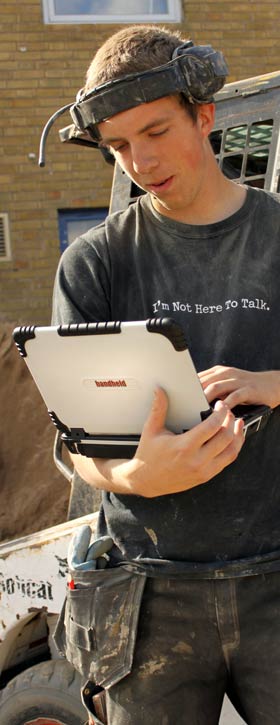
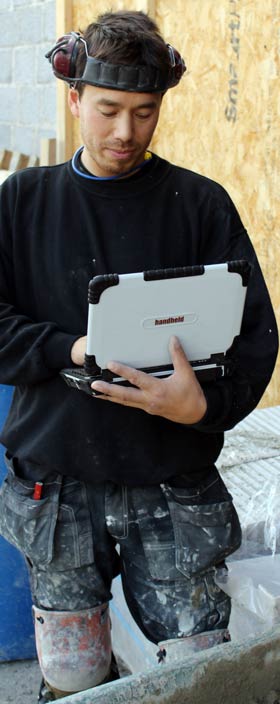
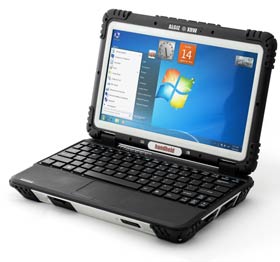
|
|
Definitions/Primers
|
|
Active vs passive digitizers
What does "rugged" mean?
Rugged Specs Primer
FIPS 201
Intrinsic Safety
NEMA Ratings
NVIS standards
IEC 60601
IP Rating
RFID
RFID vs. Bar Code
RFID viruses and
worms
RoHS
|
|
Contact
|
HHCS Handheld USA Inc.
456 SW Monroe Avenue, Suite 106
Corvallis, OR 97333, USA
Tel: (541) 752-0313
Fax: (541) 752-0338
Web: www.handheld-us.com
Email: info @ handheld-us.com
|
|
|
|








